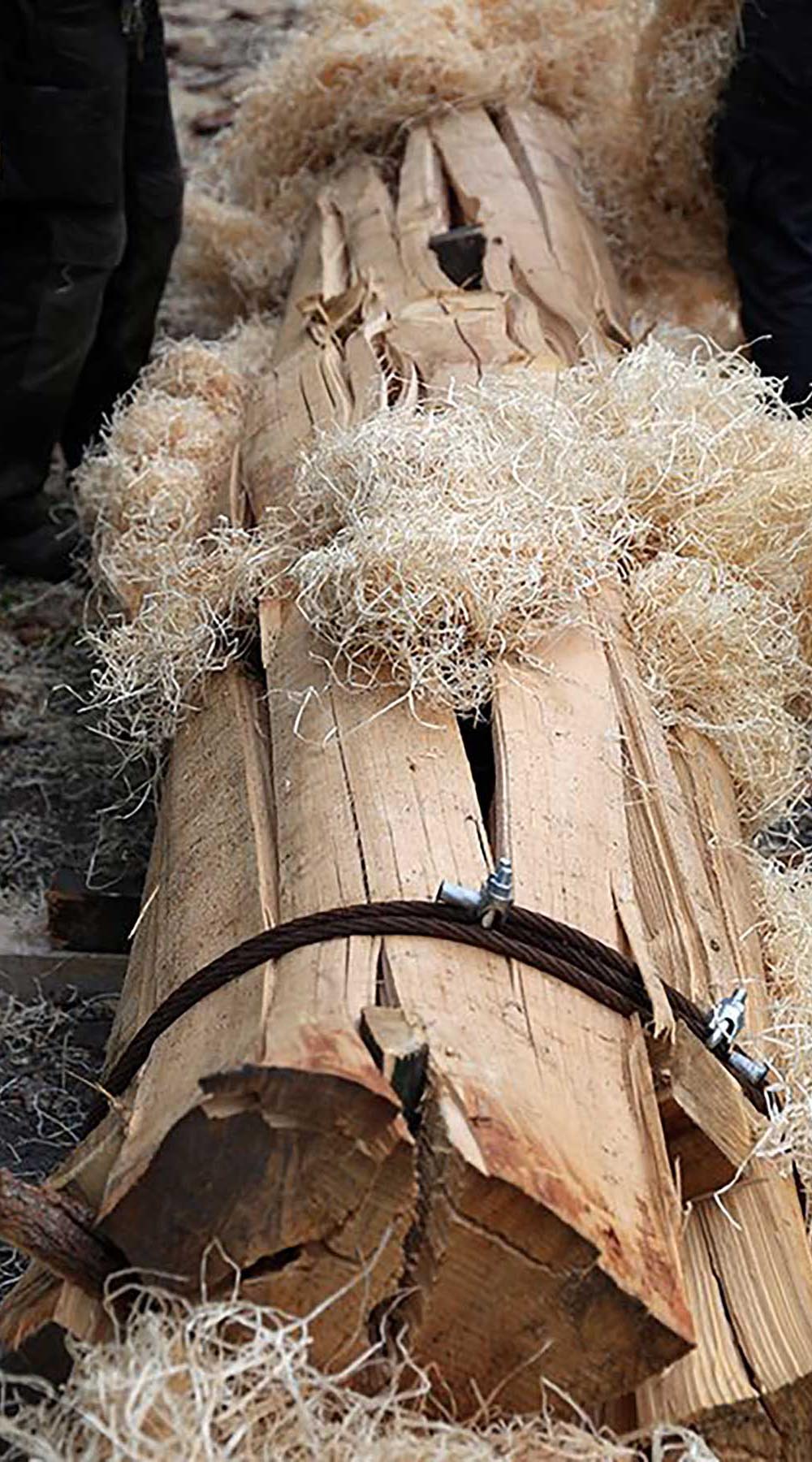Although there are 63 villages on the UNESCO list, there are many more villages in which fire festivals are held. Some were not registered at the time of the application (especially on the Occitan side) and others do not appear because they are more recent. In fact, there are more and more villages celebrating the festivals every year. Here we refer to festivals which are not present on the interactive map, but which may be added in due course. We also encourage you to provide us with information on the attached form. The museum belongs to all of us, and particularly all the villages that celebrate fire festivals.
Falles à Durro, 2015. Photography : Rafael-López-Monné (Mairie de la Vall de Boí).
Fire festivals in Occitania
Thirty-two French villages were included on the UNESCO list, but in reality, more than 90 villages celebrate Saint John’s Eve with a brandon, mainly in La Barousse and Cominges. These celebrations existed before UNESCO recognized the festivals, so they are not new, simply a reflection that they were not on the original UNESCO application.
Here is a list of villages with the name in French and Occitan (Source: CIRDOC). The list is not exhaustive and serves only as an inventory.
Barousse (Haute-Pyrénées) :
- Anla (Anlar)
- Antichan (Antishan de Varossa)
- Aveux (Avèus)
- Bertren (Bertren)
- Bramevaque (Brauvaca)
- Cazarilh (Casarilh)
- Créchets (Creishèths)
- Esbareich (Esbarèish)
- Ferrère (Harrèra)
- Gembrie (Gembria)
- Izaourt (Isaort)
- Loures-Barousse (Loras de Varossa)
- Mauléon-Barousse (Maulion de Varossa)
- Nistos (Nistòs)
- Ourde (Orda)
- Sacoué (Sàcoe)
- Sainte-Marie (Senta Maria de Varossa)
- Saléchan (Saleishan)
- Samuran (Samuran)
- Sarp (Sarp)
- Siradan (Siradan)
- Sost (Sòst)
- Troubat (Trobat)
Bigorre (Hautes-Pyrénées) :
- Bagnères-de-Bigorre (Banheras de Bigòrra)
- Cauterets (Cautarés)
Comminges (Haute-Garonne) :
- Antichan-de-Frontignes (Antishan de Frontinhas)
- Ardiège (Ardièja)
- Arguenos (Arguenòs)
- Argut-Dessous (Argut)
- Arlos (Arlòs)
- Artigue (Artiga)
- Aspet (Aspèth)
- Aventignan (Aventinhan)
- Bagiry (Bagiri)
- Bagnères-de-Luchon (Banhèras de Lushon)
- Barbazan (Barbasan)
- Benque-Dessus-Dessous (Benque)
- Bezins-Garraux (Vedins e Garraus)
- Binos (Binòs)
- Bourg-d’Oueil (Borg de Guelh)
- Boutx (Bots)
- Cabanac-Cazaux (Cabanac e Casaus)
- Castillon-de-Larboust (Castilhon de Larbost)
- Caubous (Caubós), Cazarilh-Laspènes (Casarilh)
- Cazaunous (Casaunaus)
- Chaum (Shaum)
- Cier-de-Luchon (Cièr de Luishon)
- Cierp-Gaud (Cièrp e Gaud)
- Cirès (Cirés)
- Encausse-les-Thermes (Encausse)
- Esténos (Estenòs)
- Fos (Hòs)
- Fougaron (Hogaron)
- Fronsac (Fronsac)
- Frontignan-de-Comminges (Frontinhan de Comenge)
- Garin (Garin)
- Gouaux-de-Luchon (Guaus)
- Gourdan-Polignan (Gordan e Polinhan)
- Guran (Guran)
- Huos (Uòs)
- Izaut-de-l’Hôtel (Aisaut)
- Juzet-d’Izaut (Jusèth d’Aisaut)
- Juzet-de-Luchon (Judèth de Luishon)
- Labarthe-Rivière (Era Barta d’Arribèra)
- Labroquère (Era Broquèra)
- Lombrès (Lombrés)
- Lourde (Lorda)
- Luscan (Luscan)
- Malvezie (Malavedia)
- Marignac (Marinhac)
- Mayrègne (Mairenha)
- Milhas (Milhars)
- Moncaup (Montcauv)
- Montauban-de-Luchon (Montauban de Luishon)
- Moustajon (Mostajon)
- Ôo (Òu)
- Ponlat-Taillebourg (Pontlat e Talhaborg)
- Régades (Regadas)
- Saccourvielle (Sacorvièla)
- Saint-Aventin (Sent Avantin)
- Saint-Bertrand-de-Comminges (Sent Bertran de Comenge)
- Saint-Mamet (Sent Mamet)
- Saint-Martory (Sent Martòri)
- Saint-Paul-d’Oueil (Sent Pau d’Oelh)
- Saint-Pé-d’Ardet (Sent Pè d’Ardet)
- Salles-et-Pratviel (Salas e Pratvielh)
- Sauveterre-de-Comminges (Sauvatèrra de Comenge)
- Seilhan (Selhan)
- Sengouagnet (Senguanhet)
- Valcabrère (Vathcrabèra)
- Valentine (Valentina)

Eth Har à Montauban-de-Luchon. Photography : Manel Carrera.
Fire festivals in Catalonia
Most of the villages that celebrate the festival in Catalonia were recognized by UNESCO. However, a few villages started to celebrate fire festivals after the list was submitted. Currently, we have evidence of fire festivals in 25 villages (17 on the UNESCO list). Here is a list of all these with their names in Catalan (Source: Chair of Education and Pyrenean Intangible Heritage, University of Lleida). The list serves only as an inventory.
Alt Urgell
- Alàs
Alta Ribagorça
- El Pont de Suert
- Casós
- Llesp
- Barruera
- Taüll
- Boí
- Erill la Vall
- Durro
- Vilaller
- Senet
- Gotarta
Berguedà
- Bagà
- Sant Julià de Cerdanyola
Pallars Sobirà
- Alós d’Isil
- Alins
- Isil
- València d’Àneu
- Sort
- Espot
- La Guingueta d’Àneu
Pallars Jussà
- La Pobla de Segur
Val d’Aran
- Les
- Artíes
- Bausen
Fia Fai, Bagà, 2021. Photography : Xavier Roigé
Fire festivals in Aragon
There are 9 villages in Aragon known to celebrate fire festivals (and all on the UNESCO list). The list below has names in Spanish, Aragonese, and Catalan.
Ribagorça
- Montanui (cast. Montanuy, arag. Montanui)
- Aneto
- Castanesa
- Bonansa
- Les Paüls o Laspaúls (cast. Las Paúles, arag. Las Pauls)
- Villarrué
- Suils (cat. Suïls, arag. Suils)
- Saún (cast. Sahún)
Sobrab
San Chuan de Plan (cast. San Juan de Plan)
Falles à Sahún, Aragon. Photography : Mairie de Sahún
Fire festivals in Andorra
In 2017, Andorra fallaires groups came together to form a national falla board (Taula Nacional de Falles de les Valls d’Andorra), whose aim is to protect and promote the Falles. The board works together with the Department of Cultural Heritage in Andorra to promote the festival and enable it to survive. The festival is now celebrated in all the parishes of the Principality.
According to the Government of Andorra, falles are currently celebrated in seven towns or villages (3 of which are inscribed on the UNESCO list). Here is a list of these towns in Catalan :
- Andorra la Vella
- Sant Julià de Lòria
- Escaldes-Engordany
- Encamp
- Ordino
- La Massana
- Canillo
Falles à Andorre-la-Vieille. Photogaphy : Fallaires d’Andorra.
 Occitan
Occitan


